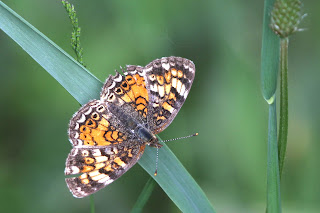So here is Part 2 :) I wanted to cover moths in a separate entry. I know even less of this group. But I do enjoy discovering them in the field every once in while; in particular, the giant silk moths (family Saturniidae)!
A few years ago, I stumbled across a Cecropia Moth (Hyalophora cecropia). According to Wikipedia, it is North America's largest native moth. Pests have become quite a threat to this species. This one that I found was in Halton Region. I believe it is a male, because its plumose antennae is very bushy (females have moderately less bushy antenna). Someone may wish to correct me.
A few weeks ago I discovered a couple of Polyphemus Moths (Antheraea polyphemus) north of Acton while conducting Bobolink/Eastern Meadowlark surveys. It was interesting comparing its features in photographs to that of its close relative the Cecropia Moth. I love the translucent eyespots or 'windows' on the wings!
 | |||
| Cecropia Moth - male |
 | |||
| Polyphemus Moth - upperside - female |
 | |||||||||||||||||
| Polyphemus Moth (underside hind and forewings) male - note large, bushy antennae |
 | ||
| Polyphemus Moth - underside hind and forewings female |
 |
| Front view of female - note small, fine antennae |
Next on my bucket list: Luna Moth!




